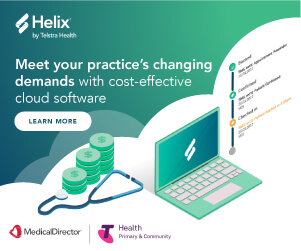How AI can help curb doctor stress and burnout
Artificial intelligence (AI) has already gained significant momentum in healthcare over the years, and in 2019, we’re already starting to see its application in helping save doctors time, beat stress and curb burnout.
The burnout epidemic
Doctors are more prone to mental health problems than any other profession, and it’s become a global epidemic.
In Australia, a special report by Insight in 2017 investigated that among doctors, suicide rates are disproportionately high and mental illness is common. In the UK, A report in the British Medical Journal in 2011 found that a third of doctors have a mental health disorder. And a Royal College of Physicians’ survey of junior doctors last year found that 70% worked on a rota that was permanently under-staffed, 80% felt their work put them under excessive stress, and a quarter felt it had a serious impact on their mental health.
Meanwhile a report last month found more than a thousand British GPs have sought professional help from the NHS GP Health Service since it was set up in 2017, with most cases involving stress, anxiety and depression and about 2% addiction.
In the US, a study by MedScape this year of 15,000 physicians from 29 specialties found 42 per cent were burnt out and 12 per cent reported colloquial depression. Female doctors seemed slightly more likely to experience burnout, with forty-eight percent of women physicians reporting it compared to 38 percent of male physicians.
New AI tool to help curb burnout
To curb doctor burnout, a new AI-enabled workflow has recently been debuted by Cerner, which joins a suite of systems designed to reduce physician burnout, enhance the clinician’s experience and increase productivity.
Cerner’s suite of AI-enabled solutions goes beyond traditional processing and focuses on user efficiency to identify gaps and inconsistencies within the patient record. These advancements will help providers address patient care and validate diagnoses, ultimately helping to reduce the physician workload, while supporting the financial strength of the health system.
“The health care environment is demanding, fast-paced and can take an emotional toll on clinicians. Cerner has set out to make the physician experience easier with our AI technology,” Cerner’s director and physician strategy executive, Dr Jeffrey Wall, said. “Some physicians express feelings of fatigue, frustration and disempowerment.
“This can have a real impact on their personal wellness and the quality of care they deliver to patients. Our new AI-driven advancement will complement our existing workflows to enhance the physician experience. Our goal is to bring real change to the industry-wide challenge of physician burnout.”
Recently, Cerner willingly participated in a study reported by MedStar Health that is designed to help push for changes to address risks to patient safety and clinician burnout. Cerner has been actively engaged in addressing burnout as an industry challenge, with focus on engaging the physician in the building of EHR workflows to better reflect how they deliver care. The use of analytics, research and feedback are key to continuously optimize solutions to deliver a more personalized and intuitive care delivery experience.
“With hundreds of millions invested in R&D, we’re evolving the EHR to deliver a more personalised and intuitive design,” Wall said. “Continued investment in AI-enabled workflows, machine learning solutions and natural language processing are key ways we’re committed to ensuring the EHR remains a tool that helps physicians do their jobs and deliver the best care.”
Freeing up time to focus on patient care
In 2018, a report released by PWC, Top health industry issues of 2018: a year of resilience amid uncertainty revealed AI is already gaining traction in healthcare’s back offices and supply chains, generating quiet efficiencies that perhaps aren’t garnering the same glamorous headlines as robotics and genomics.
According to the report, more health businesses around the world are now leveraging the power of AI to automate decision-making, create financial and administrative efficiencies, automate parts of their supply chains, or streamline regulatory compliance functions.
Repetitive tasks in particular, may benefit from the introduction of AI and machine learning to replace or supplement human interaction, the report found. AI doesn’t forget, tire, get bored with tasks or develop carpal tunnel syndrome.
But it’s important to note this doesn’t make humans redundant, in fact, it frees up healthcare professionals’ time to do less mundane tasks and focus on more personalised patient care. According to the PWC report, healthcare providers can leverage AI tools to help their staff analyse routine pathology or radiology results more quickly and accurately, allowing them to see more patients and realise greater revenues.
For instance, one of the ways AI and deep learning is already being used in healthcare is image classification, which enables extracting information from multiple images to help healthcare providers like radiologists mark file and mark low priority X-rays, making the process quicker, easier and more accurate.
Meanwhile in the UK, researchers at Oxford Hospital are using this technology to help improve diagnosis for heart disease and lung cancer. AI can also help primary doctors fund and refer patients to specialists faster, and offer more fast, accurate and actionable insights for doctors and their patients.
In China, a recent study revealed a new artificial intelligence system designed to diagnose childhood diseases, can even recognise symptoms more accurately than many human doctors.
The “deep learning” programme, tested in China, assimilated information from more than 1.4 million electronic health records.
It was then able to draw on its “experience” to diagnose a broad range of childhood diseases, with accuracy rates of more than 90% in some cases. But although the system performed better than junior doctors, it did not perform as well as more senior experienced physicians.
Respecting AI in a fear-based economy
According to MedicalDirector’s CEO, Matthew Bardsley, increased education in the healthcare sector about ways in which patients and practitioners can better leverage technology, automation and wearables to optimise and share wellness data, can open up a fresh wave of opportunities to enable more ideal healthcare and a more patient-centric approach.
“The future looks promising,” he said. “The digitally enabled practitioner will be able to see their next patient, well-equipped with the same wealth of data that the patient has on their own wellness apps and devices – and more. The clinical visit will be more open, accurate and efficient, while the patient and practitioner relationship will become more trusting, personalised and transparent.”
Disruptive technologies, AI and machine learning can be powerful tools to drive better health outcomes. But in a fear-based economy, the AI-enabled predictions need to be fully understood within the context of each individual person and their circumstances, MedicalDirector’s CEO, Matthew Bardsley said.
“Imagine if an AI-enabled health prediction tool said to you, ‘you’re going to die when you’re 70.’ You then base all your life decisions based on that prediction, but come your 70th birthday, you’re still around, but you’re alone and broke, with no set future plans in place,” he explained.
The impact prediction has in a fear-based economy is very real and has a far more implications for our individual decisions, he stressed. If the fear doesn’t manifest itself or the fear is greater than what was initially predicted, these are much harder for the human mind to cope and take on board.
“So it has to be managed a lot more carefully, and it is effectively managing predictions in a fear-based economy that we need to bear in mind as we innovate in healthcare,” he added.
For AI to really be a powerful tool in healthcare and enabler of better health outcomes, Bardsley recommended we need to make sure it is done respectfully, there is a level of empathy in the system, and a layer of emotional artificial intelligence, before it can be unleashed into the healthcare ecosystem.
“Otherwise just one health prediction delivered incorrectly can lead to a life or death situation for a patient, and stifle innovation,” he said. “Moving forward, innovators in healthcare need to understand and respect this layer of emotional AI required, and really lean into this problem and understand its repercussions, so healthcare can enjoy the same capabilities as other parts of the market.”









